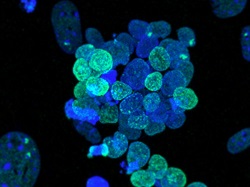 |
| A new programming method involving two genes seems to revert human pluripotent stem cells to a pristine state.--Courtesy of Takashima et al., Cell |
European and Japanese scientists have figured out how to "reset" human pluripotent stem cells, turning back the development clock on cells so that they revert to their original state at the height of their potential.
The findings, detailed in the journal Cell, could have important implications for the field of regenerative medicine and serve as a basis for new stem cell therapies.
"These cells may represent the real starting point for formation of tissues in the human embryo," said collaborator Austin Smith, director of the Wellcome Trust-Medical Research Council Stem Cell Institute, in a statement. "We hope that in time they will allow us to unlock the fundamental biology of early development, which is impossible to study directly in people."
Until now, scientists were only able to derive true embryonic stem cells--those that originate in early development and have the useful ability to turn into any type of cell--from mice and rats. In humans, it wasn't known whether it was possible to obtain these truly naïve cells, or if they even existed.
Instead, scientists have only been able to derive cells that are slightly more developed from specialized "adult" human ones, like liver, lung or skin cells. These pluripotent stem cells are early-stage cells that have slightly different properties that predispose them to becoming cells of certain types, a process called differentiation. In other words, these cells are already primed to follow a certain path.
Led by the University of Cambridge and the European Bioinformatics Institute, an international team of scientists from the U.K., Germany and Japan used a new reprogramming method designed to express two different genes, NANOG and KLF2, to reset the cells. By blocking certain biological pathways, they were able to keep the cells in a pristine state.
The introduction of these genes essentially does the same job as a protein called LIF in mice and rats. LIF is used to coax mouse cells into an embryonic state, but it doesn't work in human cells.
Researchers say the reset cells could be used for a variety of applications, such as in drug screening of patient-specific cells and for generating specialized cells for tissue grafts.
- read the press release
- get the study abstract